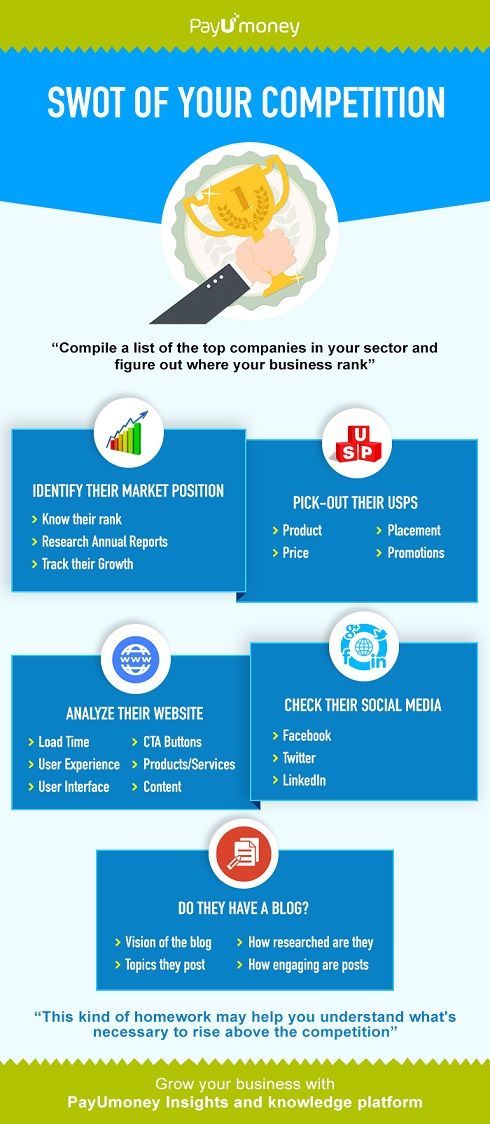In order to run your online business efficiently, you need to constantly evaluate the market you are operating in. Competitor analysis is one such paramount aspects which defines your marketing strategies. It helps you to run your online business successfully while giving you an edge over your competition.
Competition analysis is increasingly becoming important due to ever competing market. Competitor analysis determines your strength and identifies your shortcomings. It gives your online business a distinctive advantage. Today, every brand wants to capture consumer’s mind and drive them towards their products or services. Therefore it is important for you to keep a close eye on your competitor’s core strategies.
Competitive intelligence can also help you in determining your pricing, sales and on-boarding process for retailers. But before doing a competitor analysis, you must ensure that you answer the right questions. For example:
- Who are your competitors?
- What products and services they sell?
- What are their value prepositions?
- What is their marketing strategy?
- What is their strength and weakness?
- How they are approaching consumers?
- What is their customer acquisition strategy?
Below are some critical steps which will help you in determining answers to the above questions:
Identify Competitor’s Market Position
First step is to identify your competitor and its rank in the segment you are operating. The best way is to categorize them into various levels.
Primary: These are the competitors which directly targets your target audience with same or diversified product.
Secondary: These competitors have either high or low version of your products and are selling to a different target audience.
Tertiary: These competitors are related to your product or services and plays a critical role while expanding your product line-up.
Pick-Out Competitor’s USPs
Once you have identified your competitors across various categories, take a deep dig on what value prepositions they are incorporating into their consumers. Once you have located their USPs, you will gain a better understanding of your strengths and weaknesses. This process will help you to evaluate:
- What their business stands for?
- What sets them apart from you?
- Why consumers are interacting with them?
- How they are addressing consumer need?
For example, PayUmoney stands for simplifying payments and financial services for everyone through multiple payment solutions across segments.
Analyze Competitor’s Website
Next crucial step is analyzing your competitor’s website. It helps you better understand their user experience and communication strategy. Every website will be different as per their respective market. Therefore, you need to understand how they are showcasing various key elements of your website. Also consider noting crucial SEO parameters such as:
- Domain authority
- Page Title
- The URL architecture
- H1 Tags
- Content
- Internal links
- Image alt text
Check Competitor’s Social Media
Interacting with consumers on social media is increasingly dominating marketing strategies across channels. Every company is utilizing social media to target their prospect audience in the best possible way. Determine how your competitors are using social media to market their products and services.
Evaluate what kind of content and campaigns they are publishing on their respective social channels. Also map how people are interacting with their campaigns. Learn from their campaigns and take ideas to formulate your own.
Also identify which social channels they are using the most to reach out consumers. Looking out your competitor’s social media tells how customers feel about their business and what works best for them.
Does Your Competitor Blog?
Locate their blog and determine the quality of content they are driving. Make sure that you note how frequently they are publishing new content, as well as the topic on which they are writing. Once you have evaluated their content effort, you would be in a better position to mobilize your content marketing team.
If your competitors are publishing high quality content, then it will be beneficial for you to identify the value preposition they are incorporating. Don’t just try to increase frequency because you want to publish more content than your competitors. It won’t generate more traffic if your content isn’t valuable. Instead try to publish content which markets your value prepositions and caters to your customer needs.
Always research about:
- Vision of the blog
- Topics they post
- How researched are they
- How engaging are posts
Always remember, regular monitoring your competitors doesn’t mean that you are copying their campaigns or content. You don’t need to watch them like a hawk, but you should keep a tab on their activities so that you can face any challenges you encounter.
Also read our blog on, “5 Content Marketing Trends You Should Test in 2017”. Stay tuned with PayUmoney Knowledge Platform and promote your business effectively to your prospect consumers.








Leave a Comment